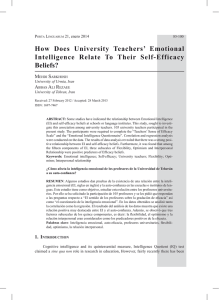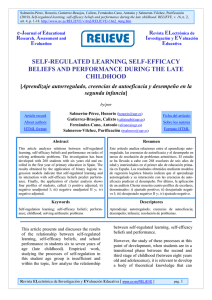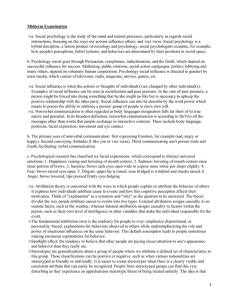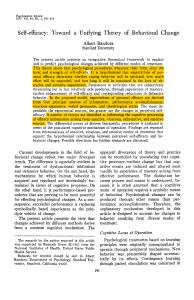Self-efficacy, risk-taking behavior and mental health as predictors of
Anuncio
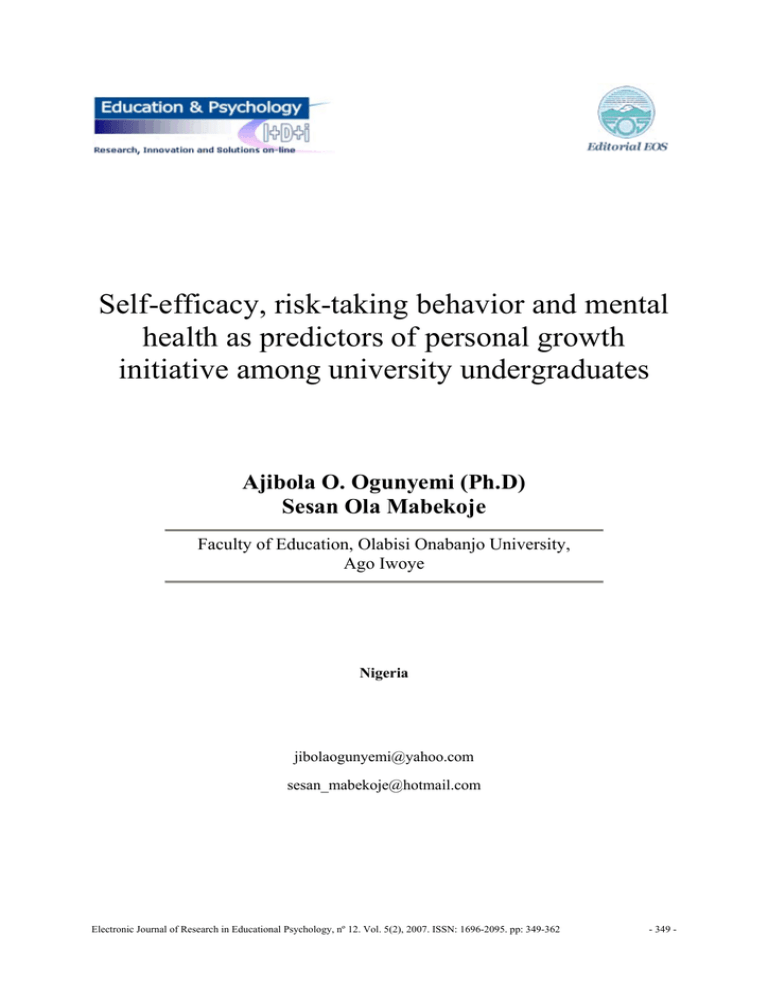
Self-efficacy, risk-taking behavior and mental health as predictors of personal growth initiative among university undergraduates Ajibola O. Ogunyemi (Ph.D) Sesan Ola Mabekoje Faculty of Education, Olabisi Onabanjo University, Ago Iwoye Nigeria [email protected] [email protected] Electronic Journal of Research in Educational Psychology, nº 12. Vol. 5(2), 2007. ISSN: 1696-2095. pp: 349-362 - 349 - Self-efficacy, risk-taking behavior and mental health as predictors of personal growth initiative … Abstract Introduction. This study sought to determine the combined and relative efficacy of selfefficacy, risk-taking behaviour and mental health on personal growth initiative of university undergraduates. Method. The expo-facto research design was used to conduct the study. Stratified random sampling technique was used to select 425 participants from 6 faculties of the Olabisi Onabanjo University, Ago Iwoye, in Ogun State, Nigeria. The age range of the participants was between 19 years and 29 years. The mean age and standard deviation of participants were 22.40 and 4.56 respectively, male = 175 and females = 250. Four validated instruments were used in collecting data. Multiple regression analysis (stepwise) and t-test statistical measures were utilized to analyze data. Results. The results indicated that risk-taking behaviour and self-efficacy together predicted 8.7% of the variation in personal growth initiative of university undergraduates. Mental health was not a good predictor of personal growth initiative. However, risk-taking behaviour, self-efficacy and mental health positively correlated with one another, and also with personal growth initiative. Discussion. Based on this finding, it was suggested that enhancing risk-taking and selfefficacy behaviours of university undergraduates would boost personal growth initiative that is desired for the social transformation of the 3rd World countries. Key Words: Self-efficacy, risk-taking behavior, mental health, personal growth initiative, university undergraduates Receipt of manuscript: Initial acceptance: Final acceptance: -350- 27-Feb-2006 17-Jan-2007 21-May-2007 Electronic Journal of Research in Educational Psychology, nº 12. Vol. 5(2), 2007. ISSN: 1696-2095. pp: 349-362 Ajibola O. Ogunyemi et al. Introduction In a world of escalating change, growing complexity like ours, one cannot but be interested in understanding factors that contribute to and enhance personal growth and development of individuals. Recently, personal growth initiative (PGI) has emerged as a promising construct in furthering human development and personal fulfillment. PGI is defined as “active, intentional engagement in the process of personal growth”, (Robitschek, 1998; p. 184). Going by this definition, individuals who are high in personal growth initiative are more involved in changing themselves in directions they desire. They are more concerned about selfimprovement than individuals who are low in PGI and who likely have less confidence in their ability to resolve life changes. Not much study has been conducted on PGI but such constructs as risk-taking behaviour (Kenealy & Herrick, 1990) and psychological well-being (Robitschek, 1997) has been undertaken with results indicating that PGI is an important construct capable of enhancing general well-being of individuals. The findings of these studies established that PGI propels people to continue seeking challenge and growth that can lead into the achievement of life goal and personal fulfilment (Robitschek, 1997). However, there are many other constructs, which could also be positively correlated with PGI that are yet to be investigated. For example, it is plausible to belief that construct like self-efficacy which is defined as people’s beliefs about their capabilities to produce designated levels of performance that exercise influence over events that affect their lives (Bandura, 1997) could enhances human accomplishment and personal growth initiative in many ways. For instance, knowledge of one’s capabilities, theoretically, should be a determinant factor towards initiating process of personal growth and fulfillment. Again, research has confirmed that people with high assurance in their capabilities approach threatening situation with assurance that they can exercise control over them and that such an efficacious outlook produces personal accomplishment. In contrast, people who doubt their capabilities have low aspirations and weak commitment to the goals they choose to pursue (Bandura, 1997). Similarly, Robitschek (1998), while amplifying the importance of PGI in individual psychological well-being affirms that individual that is high in PGI feel more confident in his/her ability to face challenges and may be better able to identify specific ways Electronic Journal of Research in Educational Psychology, nº 12. Vol. 5(2), 2007. ISSN: 1696-2095. pp: 349-362 - 351 - Self-efficacy, risk-taking behavior and mental health as predictors of personal growth initiative … to respond to events of life than someone lower in PGI. The purpose of the present study was to investigate whether self-efficacy would predict PGI and to also determine the nature of relationship between self-efficacy and PGI. Mental health is another construct whose contribution to PGI was investigated in the present work. The term mental health according to Microsoft Encarta (2004) refers to one’s capability to love and relate to others and the willingness to behave in a way that brings personal satisfaction without encroaching upon the rights of others - to be well adapted and emotionally well adjusted. It is a condition of the individual, relative to the capacities and social environment context of that person (Encyclopedia Britannica, 2003). Although, few studies have been conducted on PGI and mental health related construct such as psychological well-being (Davis-Berman & Berman, 1994; Hurwich, 1993; Robitschek, 1999; Robitschek & Kashubeck, 1999) and there is ample evidence that there could be significant positive relationship between mental health and PGI. For example, Hurwich (1993) in a longitudinal study on psychological well-being found that living in the present, experiencing life as meaningful optimism, individuality, adaptability, close relationship, continued growth and spirituality contributed to individuals psychological well-being; and all these variables are indices of mental health. However, there is dearth of research, if there has ever been any at all on the exact relationship between mental health and PGI on the one hand, and whether mental health would be able to predict PGI on the other hand. The aim of the present study therefore is to investigate whether self-efficacy, risk-taking behaviour and mental health would be able to predict personal growth initiative (PGI) among university undergraduates. Research Questions To achieve the objective of this study, the following two research questions were raised and answered in the study. 1. What was the joint contribution of self-efficacy, risk taking behaviour and mental health to student personal growth initiative? 2. How much did each of the independent variables mentioned above contribute to student personal growth initiative? -352- Electronic Journal of Research in Educational Psychology, nº 12. Vol. 5(2), 2007. ISSN: 1696-2095. pp: 349-362 Ajibola O. Ogunyemi et al. Method Participants The population for the study comprised the entire undergraduate students of the Olabisi Onabanjo University Ago Iwoye, Ogun State, Nigeria of which 425 participants were randomly selected through a stratified random sampling technique from 6 faculties (Art, Social Sciences, Social and Management Science, Education, Law and Pure Sciences) of the University. The age range of the participants was between 19 and 29 years with the mean age and standard deviation of 22.40 and 4.56 respectively. Design The expo-facto design was adopted in this study. In this kind of study, the researcher is only interested in determining the influence of the independent variables on the criterion variable without manipulating any of the independent variables. Measures Four validated and reliable instruments were used to collect data for the study. The instruments were described below. 1) Self-efficacy: This was measured by the General perceived self-efficacy scale (GPSS) developed by Schwarzer and Jerusalem (1995). It is a 10-item scale that assesses self-efficacy based on personality disposition. Participants responded by indicating their extent of agreement with each of the 10 statements using a four-point Likert scale of 1 (not at all true) to 4 (exactly true). The GPSS has demonstrated high internal consistencies with Cronbach alphas (α) ranging from .75 and .90 (Schwarzer and Jerusalem, 1995). The scale is parsimonious, reliable and culture fair. It has also proven valid in terms of convergent and discriminant validity. For example, it correlates positively with self-esteem and optimism and negatively with anxiety, depression and physical symptoms. Examples of items in the scale include “It is easy for me to stick to my aims and accomplish my goals” and “If I am in trouble, I can usually think of a solution.” Higher scores on the self-efficacy scale indicate high self-efficacy. 2) Personal Growth Initiative (PGI): Personal Growth Initiative was measured using the Personal Growth Initiative Scale (PGIS) developed by Robitschek (1998). The PGIS is a 9Electronic Journal of Research in Educational Psychology, nº 12. Vol. 5(2), 2007. ISSN: 1696-2095. pp: 349-362 - 353 - Self-efficacy, risk-taking behavior and mental health as predictors of personal growth initiative … item measure employing a 6-point Likert scale ranging from 1 (definitely disagree) to 6 (definitely agree). It is a self-report instrument that yields a single scale score for personal growth initiative. Scores can range from 9 to 54 with higher scores indicating higher levels of personal growth initiative. Sample items in the scale are “ I have a specific action plan to help me reach my goals” and “I take charge of my life” Item scores are summed to obtain a total PGI score. The internal consistency estimate of the scale ranges from .78 to .90 and a test-retest reliability estimate of .74 after 8 weeks has also been reported (Robitschek, 1998,1999). 3) Risk Taking: Risk Taking was also assessed using the International Personality Item Pool scale (Goldberg, 1999) on Risk Taking behaviour developed to be similar to that in the Jackson Personality Inventory (JPI-R). The instrument was a 10-item scale measured along a 5-point Likert Scale with options between 1 = “very inaccurate” to 5 = “very accurate”. Higher scores signify high emotional stability. Positive keyed items include “know how to get around the rules” while negative keyed items include “would never make a high risk investment” An internal consistency coefficient index of .78 has been reported (Goldberg, 1999). 4) Mental Health: Mental Health was measured using the Mental health Inventory (MHI5) developed by Veit and Ware, Jnr, (1983). The scale is a 5-item scale with options based on the 6-point Likert scale, ranging from 1 = “none of the time” to 6 = “all of the time” Items include “How much of the time, during the past month, have you felt calm and peaceful?” The MHI-5 has a maximum score of 30 and a minimum score of 5. Higher scores are desirable in that they indicate the experience of psychological well-being and the absence of psychological distress during the past month. The psychometric properties of the Mental Health Inventory (MHI-5) are very similar to those of the General Health Questionnaire (GHQ-12) (McCabe, Thomas, Brazier & Coleman, 1996). Hoeymans, Garssen, Westert and Verhaak (2004) compared the performance of the (GHQ-12) and the (MHI-5), both measures of general mental health. The agreement between the GHQ-12 and MHI-5 was found to be only modest. The correlation between GHQ-12 (score 0–12) and MHI-5 (score 0–100) is 0.64. Kappa statistics between GHQ ≥ 2 and MHI ≤ 72 was 0.49, indicating moderate agreement. Berwick, Murphy, Goldman, Ware, Barsky and Weinstein (1991) also compared the screening accuracy of the Mental Health Inventory (MHI-5) with that of the 18-item MHI, the 30item version of the General Health Questionnaire (GHQ-30), and a 28-item Somatic Symptom Inventory (SSI-28). The MHI-5 was found to be as good as the MHI-18 and the GHQ-30, -354- Electronic Journal of Research in Educational Psychology, nº 12. Vol. 5(2), 2007. ISSN: 1696-2095. pp: 349-362 Ajibola O. Ogunyemi et al. and better than the SSI-28, for detecting most significant DIS disorders, including major depression, affective disorders generally, and anxiety disorders. Areas under curve for the MHI5 ranged from 0.739 (for anxiety disorders) to 0.892 (for major depression). Single items from the MHI also performed well. The MHI-5 is increasingly used in both clinical and population studies (Hassan, 2005; McCabe, Thomas, Brazier & Coleman, 1996; Rumpf, Meyer, Hapke & John, 2001; Strand, Dalgard, Tambs & Rognerud, 2003). The present study also established correlations between MHI-5 and personal growth initiative (r = .110), self-efficacy (r = .407), and risk taking behaviour (r = .240). Procedure The instruments were administered on the participants in their various faculties with six research assistants. However, before the administration of the instruments, participants were briefed about the aims and objective of the exercise and the need for them to be as objective as possible in their responses to the items of the research instruments. The instruments were collected back immediately and later scored. The data obtained from them were analysed to answer the research questions using the Pearson Product Moment Correlation coefficient and the multiple regression (Stepwise) statistical procedures. Results were tested for significance at the .05 level. Results The intercorrelation coefficient among the three independent variables (self-efficacy, risk-taking behaviour and mental health) and the criterion variable (personal growth initiative) was positive and significant as shown above. Personal Growth Initiative positively correlated with risk-taking behaviour (r = .258; p < .05), self-efficacy (r = .225; p <.05), and with mental health (r = .110; p <. 05). Risk-taking behaviour correlated positively with self-efficacy (r = .347; p <.05) and also with mental health (r = .240; p <.05), self-efficacy and mental health positively correlated with each other (r = .407; p <.05). See Table 1. Electronic Journal of Research in Educational Psychology, nº 12. Vol. 5(2), 2007. ISSN: 1696-2095. pp: 349-362 - 355 - Self-efficacy, risk-taking behavior and mental health as predictors of personal growth initiative … Table 1: Descriptive statistics and Correlation Matrix for the relationship between Personal growth initiative, Risk taking, self-efficacy and Mental health Personal Growth Initiative Risk taking Self-efficacy Mental Health Mean Standard Deviation 46.094 25.871 32.094 18.706 5.136 4.516 4.690 3.055 Personal Growth Initiative Risk taking .258* .258* .225* .110* .347* .240* Selfefficacy Mental Health .225* .347* .110* .240* .407* .407* Going by the results presented in Table 2, all the independent variables (self-efficacy, risk-taking behaviour and mental health) put together yielded a multiple regression coefficient (R) of 0.295 and a multiple R2 of 0.087. This shows that 8.7% of the total variance in personal growth initiative of university undergraduates is accounted for by the combination of the 3 predictor variables. The table also indicates that the analysis of variance of the multiple regression data produced an F-ratio value significant at 0.05 level (F 2,422 = 20.168; p <0.05). A step was taken further to enter the predictor variables in a stepwise manner into the regression model to determine the strength of each variable in predicting the criterion variable. Results are as presented in table 3 after been tested for significance at the 0.5 level of confidence. Table 2: Summary of the Multiple Regression Analysis (Entered) of the regression of Selfefficacy, Risk taking, Mental health on Personal growth initiative. Sources of Variation Regression Sum of Squares 975.950 df 2 Mean F Square 487.97 20.168 Residual 10210.285 422 5 Total 11186.235 424 24.195 Sig. <.05 Multiple R = .295; Multiple R2 =.087; Multiple R2 (adj.) =.083 Results presented in Table 3 revealed that risk-taking behaviour and self-efficacy will significantly predict Personal Growth Initiative of University Undergraduates. When risktaking was entered into the model as the first predictor variable based on the strength of its -356- Electronic Journal of Research in Educational Psychology, nº 12. Vol. 5(2), 2007. ISSN: 1696-2095. pp: 349-362 Ajibola O. Ogunyemi et al. relationship with personal growth initiative, a significant prediction was revealed (F1,423 = 30.104; R = .258, R2 = .066; p <.05). This indicates that risk-taking alone predicted 6.6% of the variation in the personal growth initiative of university undergraduates. With self-efficacy entered into the model as the second predictor variable, a significant prediction was also revealed (F2,422 = 20.168; R = .295, R2 = .087; p <.05). This revealed that the two-predictor variables together predicted 8.7% of the variation in Undergraduate students’ personal growth initiative. Self-efficacy was able to add only 2.1% into the prediction. Mental health could not meet the criteria for it to enter the regression model. Table 3: Stepwise Multiple Regression Analysis Model Summary and Analysis of Variance of the Contributions of Self-efficacy, Risk-taking Behaviour, and Mental health to the prediction of Personal Growth Initiative (PGI) of University Undergraduates REGRESSION Model Summary MoRegression Coefficients del Multiple R = .258 A Multiple R2 = .066 Multiple R2 (adj) = .064 B Multiple R = .295 Multiple R2 = .087 Multiple R2 (adj) = .083 ANOVA R Square Change Source of Variation Sum of Squares .066 Regression Residual Total 743.202 10443.034 11186.235 .021 Regression Residual Total 975.950 10210.285 11186.235 a: Predictors: (Constant), Risk taking; c: Dependent Variable: Personal Growth Initiative df Mean Square F Sig. 1 423 424 743.202 24.688 30.104 <.05 2 422 424 487.975 24.195 20.168 <.05 b: Predictors: (Constant), Risk taking, Self-efficacy; Results presented in Table 4 shows that both risk taking and self-efficacy are good predictors of personal growth initiative of university undergraduates. They were both found to be significant at .05 level. Risk-taking (β = .204; t = 4.119; p <.05) was found to be a better predictor of personal growth initiative than self-efficacy (β = .154; t = 3.102; p <.05). This was done to provide evidence of relative importance of the predictor variables in accounting for the variations in personal growth initiative of university undergraduates. Electronic Journal of Research in Educational Psychology, nº 12. Vol. 5(2), 2007. ISSN: 1696-2095. pp: 349-362 - 357 - Self-efficacy, risk-taking behavior and mental health as predictors of personal growth initiative … Table 4: Coefficients and t values of the Regression of Risk taking Behaviour, Self-efficacy and Mental health on Personal Growth Initiative of University Undergraduates. Unstandardized Coefficients (Constant) Risk taking Self-efficacy B 34.676 .232 .168 Std. Error 1.860 .056 .054 Standardized Coefficients Beta .204 .154 t p 18.648 4.119 3.102 <.05 <.05 <.05 a: Dependent Variable: Personal Growth Initiative Discussion The results obtained showed that a combination of self-efficacy, risk-taking behaviour, and mental health when taken together are effective in predicting personal growth initiative. The observed F-ratio of 20.168, significant at .05 level is an evidence that the effectiveness of a combination of the independent variables (self-efficacy, risk-taking behaviour and mental health) in the prediction of personal growth initiative could not have occurred by chance. Furthermore, the coefficient of multiple regression of 0.295 and a multiple R square of 0.087 showed the magnitude of the relationship between personal growth initiative and the combination of the independent variables. The results indicated that a linear relationship of the three independent variables accounted for 8.7% of the total variance in personal growth initiative of university undergraduates. The results on Tables 3 and 4 are quite revealing. It indicated the extent to which each of the independent variables contributed to the prediction, and the most potent of all the predictor variables. The results in table 3 revealed that risk-taking behaviour was first entered into the model as the predictor variable based on the potency of its relationship with PGI. A significant prediction was revealed (F1,423 = 30.104;p< .05) with R square change of 0.066. This results showed that risk taking behaviour alone predicted 6.6% of the variation in PGI of university undergraduates. When self-efficacy was entered into the model as second predictor variable, a significant prediction was also revealed. (F2,422 = 20.168, R2 = 0.087; p<.05). By implication, self-efficacy also contributed additional 2.1% to the earlier contribution of risktaking behaviour, which resulted into a total of 8.7% of the total variation in the PGI of university undergraduate. The third independent variable (Mental health) could not meet the criteria for it to enter the regression model; by implication, mental health is not a good predictor -358- Electronic Journal of Research in Educational Psychology, nº 12. Vol. 5(2), 2007. ISSN: 1696-2095. pp: 349-362 Ajibola O. Ogunyemi et al. of PGI of university undergraduates. This is however, surprising, one would have expected mental health to predict PGI, but the outcome of the study presupposes that the economic situation of the country may actually be a militating factor against people that are mentally healthy willingness towards initiating process of personal growth which of course, involve some level of risk-taking. In a country where there is high level of unemployment and job insecurity like ours, people may be weary of taking risk because of the likely consequence(s) of such action. However, there is need for further research efforts to establish this presupossition and further explain the nature of relationship between mental health and PGI; more so that there is a dearth of research efforts on the construct. Furthermore, the t-ratio values of 4.119 and 3.102 for risk-taking behaviour and selfefficacy respectively showed that risk-taking behaviour is the most potent predictor of PGI. The results was anticipated in view of the fact that positive risk taking experiences makes people to continue seeking challenge (Kenealy & Herrick, 1990) and resolute in giving direction to goal achievement. In addition, students’ beliefs and knowledge are constructs of the individual that play a dynamic role in active intentional engagement in risky behaviour aim at self-growth and development. Corroborating this view further, Nicholas (2002) also affirms that risk is important to achieving programme objective and personal growth. But in view of the importance of the construct (PGI) to economic growth of a nation and personal development of individuals, and the fact that there is still a dearth of research on PGI generally, whch made it difficult for the researchers to compare these results with other related findings, caution should be taken in making generalizations. Implication of Findings The findings of the present study have some implications for economic growth and development. A situation whereby the mentally healthy who should be at the forefront of initiating action for personal growth and national developments are not disposed to taking initiative for such portends economic doom for the country development. The study also has implication for education and human development; the economic situation of the country notwithstanding, the mentally healthy should be willing to take risk for the potential benefit derivable from it. Actually, if the educational system is truly geared towards personal and national development, the mentally healthy supposed to be at the forefront of initiating process for personal growth and development. The findings of this study is a pointer to the fact that the educational system really need to be reinvigorated from its present state and geared towards perElectronic Journal of Research in Educational Psychology, nº 12. Vol. 5(2), 2007. ISSN: 1696-2095. pp: 349-362 - 359 - Self-efficacy, risk-taking behavior and mental health as predictors of personal growth initiative … sonal growth and development of the students for the nation to attain its economic height among the committee of nations through introduction of creativity oriented courses that could enhance man’s personal growth initiative. Furthermore, the government, policy makers, school administrators, counselors and other significant personnel in the education industry should work towards reawakening the sleeping giant in our students through mounting of intervention programmes that could enhance the self-efficacy for taking personal growth initiative among our students. This becomes imperative when viewed against the backdrop of the fast-placed dynamic world that we are today; and which makes PGI skill a sinequanon for man development and survival. -360- Electronic Journal of Research in Educational Psychology, nº 12. Vol. 5(2), 2007. ISSN: 1696-2095. pp: 349-362 Ajibola O. Ogunyemi et al. References Bandura, A (1997). Self-Efficacy: The Exercise of Control. (pp. 212-258). New York: Freeman. Berwick, D.M., Murphy, J.M., Goldman, P.A., Ware, A.J.A.E., Barsky, A.J., & Weinstein, M.C. (1991). Performance of a Five item Mental Health Screening Test. Medical Care, 29:169–176. Davis-Berman, J. & Berman, D. S. (1994). Wilderness Therapy: Foundations, Theory and Research. Dubuque, IA, Kendall/Hunt Publishing Company. Goldberg, L. R. (1999). A broad-bandwidth, public domain, personality inventory measuring the lower-level facets of several five-factor models. In I. Mervielde, I. Deary, F. De Fruyt, & F. Ostendorf (Eds.), Personality Psychology in Europe, 7, 7-28. Hassan, E. M. (2005). Self-efficacy, self-knowledge and empathy as determinants of mental health. Paper presented at the 1st International Conference on Human Development organised by Covenant University, Otta, Ogun State, Nigeria (June 27 – 30, 2005). Hoeymans, N., Garssen, A. A., Westert, G. P. & Verhaak, Peter FM (2004). Measuring mental health of the Dutch population: a comparison of the GHQ-12 and the MHI-5 Health Quality Life Outcomes, 2, 23.. Hurwich, C. (1993). Still Vital after All These Years: Older Women and Personal Growth. Ageing International, 20 (3), 53-57 Kenealy, K. & Herrick, K. (1990). Risk-Taking Your Way to Personal Growth. Campus Activities Programming, 23 (5), 52-54. McCabe, C.J., Thomas, K.J., Brazier, J.E. & Coleman, P. (1996). Measuring the mental health status of a population: a comparison of the GHQ-12 and the SF-36 (MHI-5). British Journal of Psychiatry, 169, 516–521. Microsoft (2004). Microsoft Encarta Encyclopedia Standard Software. Microsoft Incorporation. Nichols, G. (2002). Risk and Adventure Education. Horizons, 18, 13-20. Robitschek, C. & Kashubeck, S. (1999). A Structural Model of Parental Alcoholism, Family Functioning, and Psychological Health: The Mediating Effects of Hardiness and Personal Growth Orientation. Journal of Counseling Psychology, 46 (2), 159-72. Robitschek, C. (1997).Life/Career Renewal: An Intervention for Vocational and Other Life Transitions. Journal of Career Development, 24 (2), 133-46 Robitschek, C. (1998). Personal growth initiative: The construct and its measure. Measurement and Evaluation in Counseling and Development, 30, 183-198. Electronic Journal of Research in Educational Psychology, nº 12. Vol. 5(2), 2007. ISSN: 1696-2095. pp: 349-362 - 361 - Self-efficacy, risk-taking behavior and mental health as predictors of personal growth initiative … Robitschek, C. (1999).Further Validation of the Personal Growth Initiative Scale. Measurement and Evaluation in Counseling and Development, 31 (4), 197-210 Rumpf, H.J., Meyer, C., Hapke, U. & John, U. (2001). Screening for mental health: validity of the MHI-5 using DSM-IV axis I psychiatric disorders as gold standard. Psychiatry Research, 105, 243–53. Schwarzer, R. & Jerusalem, M. (1995). General Perceived Self-efficacy. In J. Weinmanr, S. W. & M. Johnston (eds). Measures in health Psychology: A User’s Portfolio (35 – 37) Windsor, UK:Nfer-Nelson Strand, B.H., Dalgard, O.S., Tambs, K., & Rognerud, M. (2003). Measuring the mental health status of the Norwegian population: A comparison of the instruments SCL-25, SCL-10, SCL-5 and MHI-5 (SF-36). Nord Journal of Psychiatry. 57, 113–8. Veit, C.T. & Ware, Jnr, J.E. (1983). The structure of psychological distress and well-being in general populations. Journal of Consulting and Clinical Psychology, 51, 730-742. -362- Electronic Journal of Research in Educational Psychology, nº 12. Vol. 5(2), 2007. ISSN: 1696-2095. pp: 349-362

